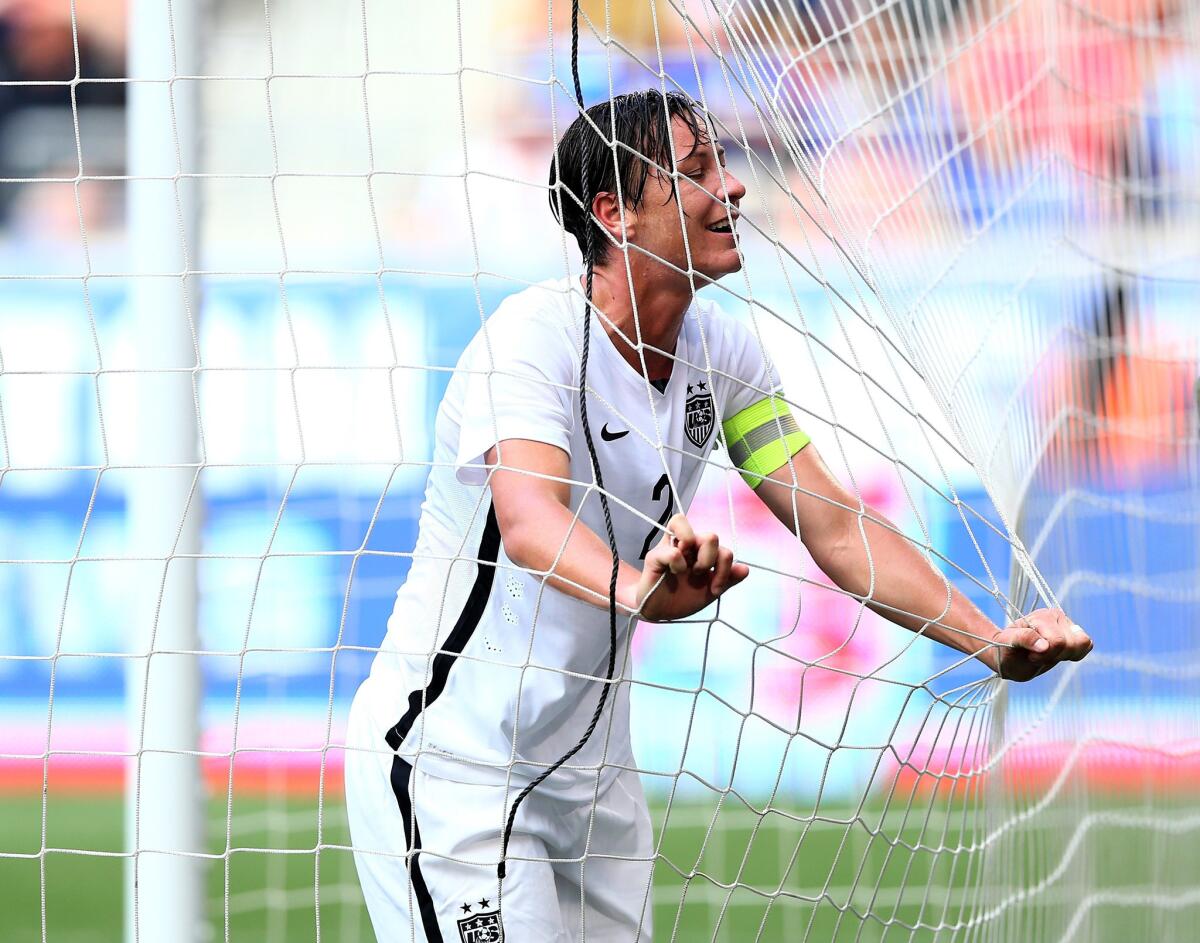Biggest Women’s World Cup in history to kick off with many contenders

U.S. forward
- Share via
Back in the day, before FIFA spent much of its time fending off criminal indictments, the organization used to put on major international soccer tournaments.
It will get back to that on Saturday, when the largest and longest Women’s World Cup in history kicks off in Edmonton, Canada. And in another break from tradition, for the first time, the U.S. won’t go into the tournament as the No. 1 team in FIFA world rankings.
This year, that honor goes to Germany, the tournament favorite. But it’s a crown the Germans are wearing lightly, because as many as half a dozen other teams can be considered serious contenders.
“International women’s football has developed enormously,” said former star sweeper Doris Fitschen, now manager of the two-time champion Germans. “The group of favorites used to be small at World Cups. Now eight teams are in the running.
“The overall level of performance has improved, and the differences in quality between teams have continuously gotten smaller.”
In addition to Germany and second-ranked U.S., France, Brazil, host Canada, Sweden and defending champion Japan all have a realistic shot at winning the title. And just behind them, England, Norway and Switzerland, playing in its first Women’s World Cup, could surprise.
But the quality of the field isn’t the only thing that’s expanded. With 24 teams and 52 games, this year’s tournament — which will be played in six cities, from Vancouver in the west to tiny Moncton in the Maritime Provinces — will be the biggest as well as the most competitive in Women’s World Cup history. And that growth has led many federations to increase the amount of money and resources they are devoting to women’s soccer, closing the gap on a U.S. team that has relied primarily on its strong college program to reach the semifinals of the previous six Women’s World Cups.
“It’s getting harder and harder. Teams are getting better and better,” U.S. midfielder Carli Lloyd said. “Long gone are the days of the Americans being able to just physically beat teams. It’s not that way anymore.”
Brazil, for example, has established a residency program that allows its players to train year-round, and Germany has 18 full-time employees — more than the U.S. — as well as an excellent youth-development program.
“They’ve set up an environment where they’re able to continue even their young players training with their staff coaches,” said Mia Hamm, who played in four World Cups for the U.S. “Japan has put an investment on that. And we have too. But we’ve probably done it about four or five years later.”
But whoever wins this summer in Canada will have to earn it. With the tournament expanding by eight teams, the finalists will play a record seven games in less than a month. And all 52 games will be played on artificial turf for the first time, adding another physical challenge.
“The players know and understand it’s competitive,” U.S. Coach Jill Ellis said. “Also, the big-picture piece is it’s seven games in 30 days. We are going to need every single player.”
Every single player may not be available, though. A knee injury kept forward Alex Morgan out of the team’s three-game send-off tour, which ended Saturday in a scoreless draw against South Korea. Morgan, who hasn’t played since early April and hasn’t scored for the U.S. since early March, remains uncertain for the team’s World Cup opener against Australia on June 8.
Midfielder Megan Rapinoe also missed Saturday’s game with a quadriceps injury, adding to the questions surrounding a roster that includes 10 players who will be at least 30 years old by the July 5 final, making it one of the oldest World Cup teams in history.
One of the most desperate teams in World Cup history as well, since the U.S., which won two of the first three World Cups, hasn’t won the title in 16 years. For many players — among them Abby Wambach, Hope Solo and Shannon Boxx — this tournament could represent their last chance at a title.
Germany — seeking to become the first nation to hold men’s and women’s World Cup titles at the same time — has injury problems too. Nadine Kessler, the reigning world player of the year, underwent knee surgery this spring, and right back Luisa Wensing broke her leg in March. And both Japan and Brazil will feature veteran rosters, with 36-year-old Homare Sawa returning from retirement to play in her sixth World Cup for Japan, a record Brazil’s Formiga figures to tie in her team’s opener a day later.
Sawa already has a world title, though, something Wambach and Formiga are still missing.
“This is a massive tournament for me,” said Wambach, whose 182 international goals are the most by any player, male or female. “This is going to be the most important tournament for everybody. We haven’t won the World Cup since 1999, and I think it’s about time that we bring the World Cup back to the United States.
“But we have to string together seven pretty good performances in order to be able to do that.”
Twitter: @kbaxter11







